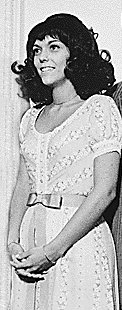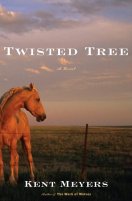FICTION
|
|

|
|

Karen Anne
Carpenter (1950-1983): American singer and drummer of the 1970s duo
Carpenters.
She suffered from
anorexia nervosa and died at the age of 32 from heart failure, later
attributed to complications related to her illness.
|

Empire Mall, Sioux Falls
|
|
BOOK
ILLUMINATIONS
From Merrimon Book Reviews
HOME
ROMANCE
FICTION SUSPENSE & THRILLERS
MYSTERY
AUTHORS REVIEWER
PROFILES
|
Twisted Tree

by Kent Meyers

Intriguing
use of narrative form
In the small town of
Twisted Tree, South Dakota, life is not as idyllic as a picture
postcard. Every resident has secrets, short comings, foibles and
failures and some have a twisted grasp on reality. Hayley Jo
Zimmerman was murdered, her absence marking the lives of the residents
from the regrets for things left unsaid to the tone of tragedy and
brokenness that shadows the lives of those left behind as they live out
their lives. One tragedy seems to give meaning to the next.
In TWISTED TREE, Kent Meyers
tells the story of Hayley Jo Zimmerman and
indeed the town of Twisted Tree through separate narratives and
separate voices from the killer's twisted tale to a supermarket clerk
who remembers the early signs of Hayley Jo's anorexia, from the
ex-priest who baptized her to strange relationship of a father and son
and the impact of divorce. Rather than pointing his vision
to the life of Hayley Jo, Kent Meyers gives readers a different
perspective and light upon his subject matter by shifting the focus to
the residents of Twisted Tree. Through the tales and voices of
those around her, Kent Meyers builds layers of unexpected and less
obvious meaning to the central event and place that unites the separate
tales. Like the description of the last photograph of Cassie, TWISTED
TREE builds a template to build the picture rather than the
picture
itself, showing a truth that a linear tale of Hayley Jo's life and
murder could not reveal. In TWISTED
TREE, Kent Meyers' narrative
joins the vision of separate voices, each an anomaly in itself.
In elucidating the coincidences and separate isolated moments in
separate lives, TWISTED TREE
paints a portrait of a town, at first
marking those random moments, and yet, as a whole the narrative redeems
each moment from a sense of coincidence.
Quite simply, TWISTED TREE is
a novel I find difficult to reduce to a
number. The author's innovative sense of structure does not
follow the set standards to which readers are accustomed. The
change in voices is not always clearly delineated at the beginning of
each chapter but rather by the voices themselves, thus demanding
attention to the narrative. The initial voice of the killer is
deeply disturbing. His words cause a certain revulsion as he
worships a skewed, deeply disturbing vision of holiness. In fact,
many of the characters are just downright unpleasant. Most are
not the kinds of people one would even imagine as the focus of the a
story, and especially not in a first person narrative. Certain
details, such as decapitation and bison excrement, are either gruesome
or just not the kinds of subjects polite society wants to hear even in
the privacy of a reading experience. In contrast to some of the
more twisted, disturbing voices, others such as the ex-priest, bring
compassion and sensitivity to small moments previously seen only in
passing. Quite simply, TWISTED
TREE is not a rural small town
story to read for relaxing after a long day or a thriller with a
fast-paced chase to the truth. Rather, it is a novel that demands
focus, concentration, and thought to derive pleasure from the sheer
brilliance of the author's artistic use of narrative. Readers who
appreciate literary experimentation and daring, cutting edge narrative
form will find a treasure trove to explore in TWISTED TREE. In
characterization, Kent Meyers' choice of unlikely narrative voices
paints a vision of a small town that breaks the stereotypes of small
town America. TWISTED TREE
is not the book I would choose for a
reading escape or to relax, and yet, it is a book I would love to study
and reread based on the author's inventiveness and narrative artistry.
Publisher: Houghton
Mifflin Harcourt (September 24, 2009)
Reviewed by Merrimon,
Merrimon Book Reviews
Review Courtesy of Amazon Vine

|
|
|